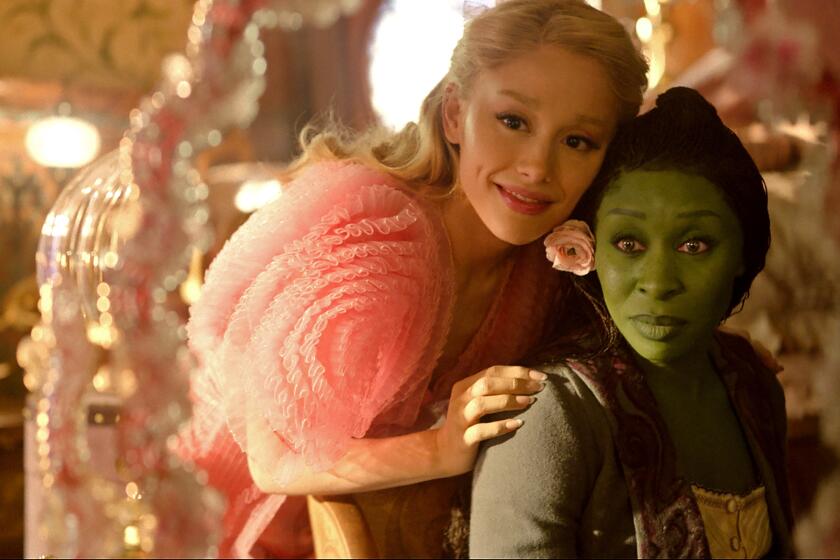The 15-Year Comic Art of Keeping Men on Their Toes
Many people who watch the Trocks are torn in two ways at once--by the similitude and yet the impiety of it all. Ballets like “Swan Lake” and “Giselle” and “Les Sylphides” are honored in the very act of destruction.
--Arlene Croce
It didn’t seem likely that a dance critic as serious-minded and theoretical as Arlene Croce would have anything good to say about a group of men who got up in toeshoes, wigs and tutus.
But from the first, Les Ballets Trockadero de Monte Carlo--which appears tonight at the Wiltern--had something in mind that went far beyond the campy dismemberment of old warhorses, or covert male snickering at a form that etherealized the body.
Since its 1974 inception, the Trocks has carried into comedy what its members first understood about dance--a congruence that worked around a vision or an idea.
Natch Taylor, one of the group’s co-founders (with Peter Anastos and Antony Bassae), observes: “We’ve been compared to Victor Borge, PDQ Bach and the Harlem Globetrotters.” And although the juxtaposition of the Globies with a concert hall performance seems far-fetched, it isn’t unlikely at all if you consider art as impulse developed into form through play (another word for experiment ).
The Trocks, like Borge, PDQ and the Globies, simply finds a different emphasis in the equation. But at bottom, the members are all deeply knowledgeable of their form.
“Swan Lake” (Act II), “Don Quixote,” “Isadora Dances” and “Gambol” will make up the troupe’s Los Angeles program, with a new section in the latter (choreographed by Taylor).
Taylor, 40, was a professional dancer from New Mexico studying in New York when he looked around and saw that “everybody in New York was so damned serious. You’d go to class for hours and nobody’d smile.”
Taylor did a lot of chamber performing, but he felt a yen to do some of what’s known in jazz parlance as “goofin’. “
For a while, a group called the Trockadero Gloxinia Ballet gave him every opportunity he needed. The Gloxinia was a glittery drag-queen show that used ballet as a pretext. But the joke got stale.
“We told the director, Larry Ree, that he had a great idea but that it had to be worked on,” Taylor recalls. “Very few people can throw out comedy and ad lib. He didn’t want to do it, so we started our own company.”
Fifteen years later, Taylor is still somewhat at a loss to describe how it is that the troupe manages to be funny. Part of it of course has to do with remaining true to a form.
“Once you get past men in tutus, what is funny?” Taylor asks rhetorically. “I think it begins with the fact that we based our stuff on the real thing. Our first piece was the Royal Ballet’s ‘Swan Lake,’ notated by Cyril Beaumont. Our ‘Don Quixote’ was drawn from the Bolshoi and the Kirov.
“Everything we do is based on historical fact. You have to have a foundation, or else it’s Hasty Pudding.”
Taylor was intuitively mindful as well that the best parody depends on teasing an audience’s perceptions. In this instance, the Trocks wanted to remind us that when our willing suspension of disbelief becomes automatic or unconscious, we’ve lost a certain freshness about the thing observed and its occasion.
“When you break it down, ballet is absurd,” Taylor says. “Falling in love with swans. Dancing on your toes. It’s a highly specialized thing.”
Taylor is clear to dissociate the Trocks from a gay outfit getting off on ballet, incidentally, though the troupe’s first appearance was at a New York homophile venue owned by the West Side Discussion Group.
“The gay revolution may have helped us,” Taylor says. “But we did nothing to expand on it. We hear complaints from gay political organizations to make a statement, but we’re not a gay political unit. We’re a ballet company.”
A ballet company continually puzzling its unique balances:
“It’s difficult, being funny,” Taylor says. “I can’t explain exactly how it works. I have to rely on my feeling, ‘Is this believable?’ Exaggeration and mistakes are perfectly fine, but it just can’t come out of the blue. Then, it’s slapstick. There has to be a logical reason for what you’re doing that takes place in a larger framework.
“For instance, in ‘Swan Lake,’ the ballerina falls because she’s tired. The audience can buy that. It isn’t jarring, like a banana pratfall would be.
“Balance, attitude and timing are all crucial. All the great comedians, from Danny Kaye to Burns and Allen and Jack Benny have it.
“An example of balance and attitude: I’m 6-foot-2. On pointe, I’m 6-foot-6 and 190 pounds. As Suzina, I see myself as a pretty little ballerina. When you see someone that tall miming petite, it’s humorous, but not if I did it like a big galumphing guy playing small. You let the audience read your mind.”
Of his constantly changing company of 10, he says “It can take up to two years to really know if you have somebody. Sometimes people who’re promising just don’t pan out. Personally, I can get away with murder onstage. Why I can, and somebody else can’t, is a mystery.”
More to Read
The biggest entertainment stories
Get our big stories about Hollywood, film, television, music, arts, culture and more right in your inbox as soon as they publish.
You may occasionally receive promotional content from the Los Angeles Times.










